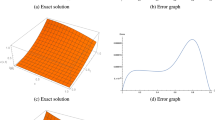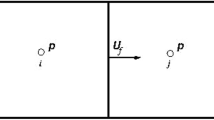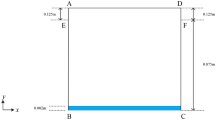Appendix
The coefficients and functions that appeared in the formulation of the problem are given below.
Derivation of kinematical tensor (\(A_{1}\))
To find \({A}_{1}=\nabla V+(\nabla {V)}^\text{T}\):
$$\nabla V = \nabla \otimes V = \left( {e_{{\text{r}}} \frac{\partial }{\partial r} + e_{{\uptheta }} \frac{1}{r}\frac{\partial }{\partial \theta }} \right) \otimes \left( {u\,e_{{\text{r}}} + v\,e_{{\uptheta }} } \right)$$
$$\nabla V = e_{{\text{r}}} \otimes \frac{{\partial \left( {u\,e_{{\text{r}}} } \right)}}{\partial r} + e_{{\text{r}}} \otimes \frac{{\partial \left( {v\,e_{{\uptheta }} } \right)}}{\partial r} + e_{{\uptheta }} \otimes \frac{1}{r}\frac{{\partial \left( {u\,e_{{\text{r}}} } \right)}}{\partial \theta } + e_{{\uptheta }} \otimes \frac{1}{r}\frac{{\partial \left( {v\,e_{{\uptheta }} } \right)}}{\partial \theta }$$
$$\nabla V = e_\text{r} \otimes u\frac{{\partial e_{{\text{r}}} }}{\partial r} + e_{{\text{r}}} \otimes \frac{\partial u}{{\partial r}}e_{{\text{r}}} + e_{{\text{r}}} \otimes v\frac{{\partial e_{{\uptheta }} }}{\partial r} + e_{{\text{r}}} \otimes e_{{\uptheta }} \frac{\partial v}{{\partial r}} + e_{{\uptheta }} \otimes \frac{u}{r}\frac{{\partial \,e_{{\text{r}}} }}{\partial \theta } + e_{{\uptheta }} \otimes \frac{1}{r}\,e_{{\text{r}}} \frac{\partial u}{{\partial \theta }} + e_{{\uptheta }} \otimes \frac{v}{r}\frac{{\partial e_{{\uptheta }} }}{\partial \theta } + e_{{\uptheta }} \otimes \frac{1}{r}e_{{\uptheta }} \frac{\partial v}{{\partial \theta }}$$
We know that \(\frac{{\partial e_{{\text{r}}} }}{\partial r} = \frac{{\partial e_{{\uptheta }} }}{\partial r} = 0;\,\,\frac{{\partial \,e_{{\text{r}}} }}{\partial \theta } = e_{{\uptheta }} ,\,\frac{{\partial e_{{\uptheta }} }}{\partial \theta } = - e_{{\text{r}}}\)
$$\nabla V = e_{{\text{r}}} \otimes u\left( 0 \right) + e_{{\text{r}}} \otimes \frac{\partial u}{{\partial r}}e_{{\text{r}}} + e_{{\text{r}}} \otimes v\left( 0 \right) + e_{{\text{r}}} \otimes e_{{\uptheta }} \frac{\partial v}{{\partial r}} + e_{{\uptheta }} \otimes \frac{u}{r}\left( {e_{{\uptheta }} } \right) + e_{{\uptheta }} \otimes \frac{1}{r}\,e_{{\text{r}}} \frac{\partial u}{{\partial \theta }} + e_{{\uptheta }} \otimes \frac{v}{r}\left( { - e_{{\text{r}}} } \right) + e_{{\uptheta }} \otimes \frac{1}{r}e_{{\uptheta }} \frac{\partial v}{{\partial \theta }}$$
$$\nabla V = e_{{\text{r}}} \otimes \frac{\partial u}{{\partial r}}e_{{\text{r}}} + e_{{\text{r}}} \otimes e_{{\uptheta }} \frac{\partial v}{{\partial r}} + e_{{\uptheta }} \otimes \frac{u}{r}\left( {e_{{\uptheta }} } \right) + e_{{\uptheta }} \otimes \frac{1}{r}\,e_{{\text{r}}} \frac{\partial u}{{\partial \theta }} + e_{{\uptheta }} \otimes \frac{v}{r}\left( { - e_{{\text{r}}} } \right) + e_{{\uptheta }} \otimes \frac{1}{r}e_{{\uptheta }} \frac{\partial v}{{\partial \theta }}$$
$$\nabla V = \frac{\partial u}{{\partial r}}e_{{\text{r}}} \otimes e_{{\text{r}}} + \frac{\partial v}{{\partial r}}e_{{\text{r}}} \otimes e_{{\uptheta }} + \frac{u}{r}e_{{\uptheta }} \otimes e_{{\uptheta }} + \frac{1}{r}\,\frac{\partial u}{{\partial \theta }}e_{{\uptheta }} \otimes e_{{\text{r}}} - \frac{v}{r}e_{{\uptheta }} \otimes e_{{\text{r}}} + \frac{1}{r}\frac{\partial v}{{\partial \theta }}e_{{\uptheta }} \otimes e_{{\uptheta }}$$
$$\nabla V = \frac{\partial u}{{\partial r}}e_{{\text{r}}} \otimes e_{{\text{r}}} + \frac{\partial v}{{\partial r}}e_{{\text{r}}} \otimes e_{{\uptheta }} + \left( {\frac{1}{r}\,\frac{\partial u}{{\partial \theta }} - \frac{v}{r}} \right)e_{{\uptheta }} \otimes e_{{\text{r}}} + \left( {\frac{1}{r}\frac{\partial v}{{\partial \theta }} + \frac{u}{r}} \right)e_{{\uptheta }} \otimes e_{{\uptheta }}$$
\(\nabla V = \left[ {\begin{array}{*{20}c} {\frac{\partial u}{{\partial r}}} & {\frac{\partial v}{{\partial r}}} \\ {\frac{1}{r}\,\frac{\partial u}{{\partial \theta }} - \frac{v}{r}} & {\frac{1}{r}\frac{\partial v}{{\partial \theta }} + \frac{u}{r}} \\ \end{array} } \right]\) and \(\left( {\nabla V} \right)^{T} = \left[ {\begin{array}{*{20}c} {\frac{\partial u}{{\partial r}}} & {\frac{1}{r}\,\frac{\partial u}{{\partial \theta }} - \frac{v}{r}} \\ {\frac{\partial v}{{\partial r}}} & {\frac{1}{r}\frac{\partial v}{{\partial \theta }} + \frac{u}{r}} \\ \end{array} } \right]\)
$$A_{1} = \nabla V + \left( {\nabla V} \right)^\text{T} = \left[ {\begin{array}{*{20}c} {\frac{\partial u}{{\partial r}}} & {\frac{\partial v}{{\partial r}}} \\ {\frac{1}{r}\,\frac{\partial u}{{\partial \theta }} - \frac{v}{r}} & {\frac{1}{r}\frac{\partial v}{{\partial \theta }} + \frac{u}{r}} \\ \end{array} } \right] + \left[ {\begin{array}{*{20}c} {\frac{\partial u}{{\partial r}}} & {\frac{1}{r}\,\frac{\partial u}{{\partial \theta }} - \frac{v}{r}} \\ {\frac{\partial v}{{\partial r}}} & {\frac{1}{r}\frac{\partial v}{{\partial \theta }} + \frac{u}{r}} \\ \end{array} } \right]$$
$$A_{1} = \nabla V + \left( {\nabla V} \right)^\text{T} = \left[ {\begin{array}{*{20}c} {2\frac{\partial u}{{\partial r}}} & {\frac{1}{r}\,\frac{\partial u}{{\partial \theta }} + \frac{\partial v}{{\partial r}} - \frac{v}{r}} \\ {\frac{1}{r}\,\frac{\partial u}{{\partial \theta }} + \frac{\partial v}{{\partial r}} - \frac{v}{r}} & {2\left( {\frac{1}{r}\frac{\partial v}{{\partial \theta }} + \frac{u}{r}} \right)} \\ \end{array} } \right] = \left[ {\begin{array}{*{20}c} {A_\text{rr} } & {A_{\text{r}\uptheta }} \\ {A_{\uptheta\text{r}} } & {A_{\uptheta \uptheta } } \\ \end{array} } \right]$$
$$A_{1}^{2} = \left[ {\begin{array}{*{20}c} {2\frac{\partial u}{{\partial r}}} & {\frac{1}{r}\,\frac{\partial u}{{\partial \theta }} + \frac{\partial v}{{\partial r}} - \frac{v}{r}} \\ {\frac{1}{r}\,\frac{\partial u}{{\partial \theta }} + \frac{\partial v}{{\partial r}} - \frac{v}{r}} & {2\left( {\frac{1}{r}\frac{\partial v}{{\partial \theta }} + \frac{u}{r}} \right)} \\ \end{array} } \right]\,\,\,\left[ {\begin{array}{*{20}c} {2\frac{\partial u}{{\partial r}}} & {\frac{1}{r}\,\frac{\partial u}{{\partial \theta }} + \frac{\partial v}{{\partial r}} - \frac{v}{r}} \\ {\frac{1}{r}\,\frac{\partial u}{{\partial \theta }} + \frac{\partial v}{{\partial r}} - \frac{v}{r}} & {2\left( {\frac{1}{r}\frac{\partial v}{{\partial \theta }} + \frac{u}{r}} \right)} \\ \end{array} } \right]$$
$$A_{1}^{2} = \left[ {\begin{array}{*{20}l} {4\left( {\frac{\partial u}{{\partial r}}} \right)^{2} + \left( {\frac{1}{r}\,\frac{\partial u}{{\partial \theta }} + \frac{\partial v}{{\partial r}} - \frac{v}{r}} \right)^{2} } \hfill & W \hfill \\ W \hfill & {\left( {\frac{1}{r}\,\frac{\partial u}{{\partial \theta }} + \frac{\partial v}{{\partial r}} - \frac{v}{r}} \right)^{2} + 4\left( {\frac{1}{r}\frac{\partial v}{{\partial \theta }} + \frac{u}{r}} \right)^{2} } \hfill \\ \end{array} } \right]$$
where \(W = 2\frac{\partial u}{{\partial r}}\left( {\frac{1}{r}\,\frac{\partial u}{{\partial \theta }} + \frac{\partial v}{{\partial r}} - \frac{v}{r}} \right) + 2\left( {\frac{1}{r}\frac{\partial v}{{\partial \theta }} + \frac{u}{r}} \right)\left( {\frac{1}{r}\,\frac{\partial u}{{\partial \theta }} + \frac{\partial v}{{\partial r}} - \frac{v}{r}} \right)\) and
$$\dot{\gamma }^{2} = \frac{1}{2}Tr\left( {A_{1}^{2} } \right) = 2\left( {\frac{\partial u}{{\partial r}}} \right)^{2} + \left( {\frac{1}{r}\,\frac{\partial u}{{\partial \theta }} + \frac{\partial v}{{\partial r}} - \frac{v}{r}} \right)^{2} + 2\left( {\frac{1}{r}\frac{\partial v}{{\partial \theta }} + \frac{u}{r}} \right)^{2} .$$
Now, \(\Gamma = \left( {\mu + \frac{1}{\beta d} - \frac{{\dot{\gamma }^{2} }}{{6\beta d^{3} }}} \right)A_{1}\).
We know that \(A_{1} = \left[ {\begin{array}{*{20}c} {A_\text{rr} } & {A_{\text{r}\uptheta } } \\ {A_{\uptheta \text{r}} } & {A_{\uptheta \uptheta } } \\ \end{array} } \right]\) then
$$\Gamma_{{{\text{rr}}}} = \left( {\mu + \frac{1}{\beta d} - \frac{{\dot{\gamma }^{2} }}{{6\beta d^{3} }}} \right)A_{{{\text{rr}}}}$$
$$\Gamma _{{\text{r}\uptheta }} = \left( {\mu + \frac{1}{{\beta d}} - \frac{{\dot{\gamma }^{2} }}{{6\beta d^{3} }}} \right)A_{{\text{r}\uptheta }}$$
$$\Gamma _{{\theta \theta }} = \left( {\mu + \frac{1}{{\beta d}} - \frac{{\dot{\gamma }^{2} }}{{6\beta d^{3} }}} \right)A_{{\theta \theta }}$$
Derivation of general momentum equation:
$$\rho \left[ {\frac{{\partial \vec{q}}}{\partial t} + \left( {\vec{q} \cdot \nabla } \right)\vec{q}} \right] = - \nabla p + \nabla \cdot \Gamma$$
(i) Expression of \(\left( {\vec{q} \cdot \nabla } \right)\vec{q}\):
$$\vec{q} \cdot \nabla = \left( {u\,e_{{\text{r}}} + v\,e_{{\uptheta }} } \right) \cdot \left( {e_{{\text{r}}} \frac{\partial }{\partial r} + e_{{\uptheta }} \frac{1}{r}\frac{\partial }{\partial \theta }} \right) = u\frac{\partial }{\partial r} + v\frac{1}{r}\frac{\partial }{\partial \theta }$$
$$\left( {\vec{q} \cdot \nabla } \right)\vec{q} = \left( {u\frac{\partial }{\partial r} + v\frac{1}{r}\frac{\partial }{\partial \theta }} \right)\left( {u\,e_{{\text{r}}} + v\,e_{{\uptheta }} } \right)$$
$$\left( {\vec{q} \cdot \nabla } \right)\vec{q} = u\frac{{\partial \left( {u\,e_{{\text{r}}} } \right)}}{\partial r} + u\frac{{\partial \left( {v\,e_{{\uptheta }} } \right)}}{\partial r} + v\frac{1}{r}\frac{{\partial \left( {u\,e_{{\text{r}}} } \right)}}{\partial \theta } + v\frac{1}{r}\frac{{\partial \left( {v\,e_{{\uptheta }} } \right)}}{\partial \theta }$$
$$\left( {\vec{q} \cdot \nabla } \right)\vec{q} = u\,\,u\frac{{\partial \left( {\,e_{{\text{r}}} } \right)}}{\partial r} + u\,\frac{\partial u}{{\partial r}}e_{{\text{r}}} + u\,v\frac{{\partial \left( {e_{{\uptheta }} } \right)}}{\partial r} + u\,\,\frac{\,\partial v}{{\partial r}}e_{{\uptheta }} + u\,v\frac{1}{r}\frac{{\partial \left( {e_{{\text{r}}} } \right)}}{\partial \theta } + v\frac{1}{r}\frac{\partial u}{{\partial \theta }}e_{{\text{r}}} + v\,v\frac{1}{r}\frac{{\partial \left( {\,e_{{\uptheta }} } \right)}}{\partial \theta } + v\frac{1}{r}\frac{\partial v}{{\partial \theta }}e_{{\uptheta }}$$
We know that \(\frac{{\partial \left( {\,e_{{\text{r}}} } \right)}}{\partial r} = \frac{{\partial \left( {e_{{\uptheta }} } \right)}}{\partial r} = 0;\frac{{\partial \left( {e_{{\text{r}}} } \right)}}{\partial \theta } = e_{{\uptheta }} ,\,\,\frac{{\partial \left( {\,e_{{\uptheta }} } \right)}}{\partial \theta } = - e_{{\text{r}}}\)
$$\left( {\vec{q} \cdot \nabla } \right)\vec{q} = u\,\,u\left( 0 \right) + u\,\frac{\partial u}{{\partial r}}e_{{\text{r}}} + u\,v\left( 0 \right) + u\,\,\frac{\,\partial v}{{\partial r}}e_{{\uptheta }} + u\,v\frac{1}{r}\left( {e_{{\uptheta }} } \right) + v\frac{1}{r}\frac{\partial u}{{\partial \theta }}e_{{\text{r}}} + v\,v\frac{1}{r}\left( { - e_{{\text{r}}} } \right) + v\frac{1}{r}\frac{\partial v}{{\partial \theta }}e_{{\uptheta }}$$
$$\left( {\vec{q} \cdot \nabla } \right)\vec{q} = \left( {u\,\frac{\partial u}{{\partial r}} + \frac{v}{r}\frac{\partial u}{{\partial \theta }} - \frac{{v^{2} }}{r}} \right)e_{{\text{r}}} + \left( {u\,\,\frac{\,\partial v}{{\partial r}} + \frac{v}{r}\frac{\partial v}{{\partial \theta }} + \frac{u\,v}{r}} \right)e_{{\uptheta }}$$
(ii) Expressions of the shears of Eyring–Powell fluid in polar coordinates (\(\Gamma_\text{rr} ,\,\Gamma_{\text{r}\uptheta } ,\,\Gamma_{\uptheta \uptheta }\)):
$$\nabla \cdot \Gamma = \left( {e_\text{r} \frac{\partial }{{\partial r}} + e_{\uptheta } \frac{1}{r}\frac{\partial }{{\partial \theta }}} \right) \cdot \left[ {\Gamma _\text{{rr}} e_\text{r} \otimes e_\text{r} + \Gamma _{{\text{r}\uptheta }} e_\text{r} \otimes e_{\uptheta } + \Gamma _{{\uptheta \text{r}}} e_{\uptheta } \otimes e_\text{r} + \Gamma _{{\uptheta \uptheta }} e_{\uptheta } \otimes e_{\uptheta } } \right]$$
$$\begin{gathered} \nabla \cdot \Gamma = \left( {e_\text{r} \frac{\partial }{{\partial r}}} \right) \cdot \left[ {\Gamma _\text{{rr}} e_\text{r} \otimes e_\text{r} + \Gamma _{{\text{r}\uptheta }} e_\text{r} \otimes e_{\uptheta } + \Gamma _{{\uptheta \text{ r}}} e_{\uptheta } \otimes e_\text{r} + \Gamma _{{\uptheta \uptheta }} e_{\uptheta } \otimes e_{\uptheta } } \right] + \hfill \\ \,\,\,\,\,\,\,\,\,\,\,\,\,\left( {e_{\theta } \frac{1}{r}\frac{\partial }{{\partial \theta }}} \right) \cdot \left[ {\Gamma _\text{{rr}} e_\text{r} \otimes e_\text{r} + \Gamma _{{\text{r}\uptheta }} e_\text{r} \otimes e_{\uptheta } + \Gamma _{{\uptheta \text{r}}} e_{\uptheta } \otimes e_\text{r} + \Gamma _{{\uptheta \uptheta }} e_{\uptheta } \otimes e_{\uptheta } } \right] \hfill \\ \end{gathered}$$
$$\begin{gathered} \nabla \cdot \Gamma = \left( {e_\text{r} \frac{\partial }{{\partial r}}} \right) \cdot \left( {\Gamma _\text{{rr}} e_\text{r} \otimes e_\text{r} } \right) + \left( {e_\text{r} \frac{\partial }{{\partial r}}} \right) \cdot \left( {\Gamma _{{\text{r}\uptheta }} e_\text{r} \otimes e_{\uptheta } } \right) + \left( {e_\text{r} \frac{\partial }{{\partial r}}} \right) \cdot \left( {\Gamma _{{\uptheta\text{r}}} e_{\uptheta } \otimes e_\text{r} } \right) + \left( {e_\text{r} \frac{\partial }{{\partial r}}} \right) \cdot \left( {\Gamma _{{\uptheta \uptheta }} e_{\uptheta } \otimes e_{\uptheta } } \right) + \hfill \\ \left( {\frac{{e_{\uptheta } }}{\text{r}}\frac{\partial }{{\partial \theta }}} \right) \cdot \left( {\Gamma _\text{{rr}} e_\text{r} \otimes e_\text{r} } \right) + \left( {\frac{{e_{\uptheta } }}{\text{r}}\frac{\partial }{{\partial \theta }}} \right) \cdot \left( {\Gamma _{{\text{r}\uptheta }} e_\text{r} \otimes e_{\uptheta } } \right) + \left( {\frac{{e_{\uptheta } }}{\text{r}}\frac{\partial }{{\partial \theta }}} \right) \cdot \left( {\Gamma _{{\uptheta\text{r}}} e_{\uptheta } \otimes e_\text{r} } \right) + \left( {\frac{{e_{\uptheta } }}{r}\frac{\partial }{{\partial \theta }}} \right) \cdot \left( {\Gamma _{{\uptheta \uptheta }} e_{\uptheta } \otimes e_{\uptheta } } \right) \hfill \\ = a_{1} + a_{2} + a_{3} + a_{4} + a_{5} + a_{6} + a_{7} + a_{8} \hfill \\ \end{gathered}$$
$$\begin{aligned} a_{1} = & \left( {e_{{\text{r}}} \frac{\partial }{\partial r}} \right) \cdot \left( {\Gamma_{{{\text{rr}}}} e_{{\text{r}}} \otimes e_{{\text{r}}} } \right) = e_{{\text{r}}} \cdot \frac{\partial }{\partial r}\left( {\Gamma_{{{\text{rr}}}} e_{{\text{r}}} \otimes e_{{\text{r}}} } \right) = e_{{\text{r}}} \cdot \left[ {\frac{{\partial \Gamma_{{{\text{rr}}}} }}{\partial r}\left( {e_{{\text{r}}} \otimes e_{{\text{r}}} } \right) + \Gamma_{{{\text{rr}}}} \left( {\frac{{\partial e_{{\text{r}}} }}{\partial r} \otimes e_{{\text{r}}} } \right) + \Gamma_{{{\text{rr}}}} \left( {e_{{\text{r}}} \otimes \frac{{\partial e_{{\text{r}}} }}{\partial r}} \right)} \right] \\ = & \frac{{\partial \Gamma_{{{\text{rr}}}} }}{\partial r}e_{{\text{r}}} \,\,\,\,\,\,\,\,\left( {\because \frac{{\partial e_{{\text{r}}} }}{\partial r} = 0} \right) \\ \end{aligned}$$
$$\begin{aligned} a_{2} = & \left( {e_\text{r} \frac{\partial }{{\partial r}}} \right) \cdot \left( {\Gamma _{{\text{r}\uptheta }} e_\text{r} \otimes e_{\uptheta } } \right) = e_\text{r} \cdot \frac{\partial }{{\partial r}}\left( {\Gamma _{{\text{r}\uptheta }} e_\text{r} \otimes e_{\uptheta } } \right) = e_\text{r} \cdot \left[ {\frac{{\partial \Gamma _{{\text{r}\uptheta }} }}{{\partial r}}\left( {e_\text{r} \otimes e_{\uptheta } } \right) + \Gamma _{{\text{r}\uptheta }} \left( {\frac{{\partial e_{r} }}{{\partial r}} \otimes e_{\uptheta } } \right) + \Gamma _{{\text{r}\uptheta }} \left( {e_\text{r} \otimes \frac{{\partial e_{\uptheta } }}{{\partial r}}} \right)} \right] \\ = & \frac{{\partial \Gamma _{{\text{r}\uptheta }} }}{{\partial r}}e_{\uptheta } \,\left( {\because \frac{{\partial e_\text{r} }}{{\partial r}} = \frac{{\partial e_{\uptheta } }}{{\partial r}} = 0} \right) \\ \end{aligned}$$
$$\begin{aligned} a_{3} = & \left( {e_{{\text{r}}} \frac{\partial }{\partial r}} \right) \cdot \left( {\Gamma_{{{\uptheta \text{r}}}} e_{{\uptheta }} \otimes e_{{\text{r}}} } \right) = e_{{\text{r}}} \cdot \frac{\partial }{\partial r}\left( {\Gamma_{{{\uptheta \text{r}}}} e_{{\uptheta }} \otimes e_{{\text{r}}} } \right) = e_{{\text{r}}} \cdot \left[ {\frac{{\partial \Gamma_{{{\uptheta \text{r}}}} }}{\partial r}\left( {e_{{\uptheta }} \otimes e_{{\text{r}}} } \right) + \Gamma_{{{\uptheta \text{r}}}} \left( {\frac{{\partial e_{{\uptheta }} }}{\partial r} \otimes e_{{\text{r}}} } \right) + \Gamma_{{{\uptheta \text{r}}}} \left( {e_{{\uptheta }} \otimes \frac{{\partial e_{{\text{r}}} }}{\partial r}} \right)} \right] = 0 \\ & \left( {\because e_{{\text{r}}} \cdot \left( {e_{{\uptheta }} \otimes e_{{\text{r}}} } \right) = \frac{{\partial e_{{\uptheta }} }}{\partial r} = \frac{{\partial e_{{\text{r}}} }}{\partial r} = 0} \right) \\ \end{aligned}$$
$$\begin{gathered} a_{4} = \left( {e_\text{r} \frac{\partial }{{\partial r}}} \right) \cdot \left( {\Gamma _{{\uptheta \uptheta }} e_{\uptheta } \otimes e_{\uptheta } } \right) = e_\text{r} \cdot \frac{\partial }{{\partial r}}\left( {\Gamma _{{\uptheta \uptheta }} e_{\uptheta } \otimes e_{\uptheta } } \right) = e_\text{r} \cdot \left[ {\frac{{\partial \Gamma _{{\uptheta \uptheta }} }}{{\partial r}}\left( {e_{\uptheta } \otimes e_{\uptheta } } \right) + \Gamma _{{\uptheta \uptheta }} \left( {\frac{{\partial e_{\uptheta } }}{{\partial r}} \otimes e_{\uptheta } } \right) + \Gamma _{{\uptheta \uptheta }} \left( {e_{\theta } \otimes \frac{{\partial e_{\uptheta } }}{{\partial r}}} \right)} \right] = 0 \hfill \\ \left( {\because e_\text{r} \cdot \left( {e_{\uptheta } \otimes e_{\uptheta } } \right) = \frac{{\partial e_{\uptheta } }}{{\partial r}} = \frac{{\partial e_\text{r} }}{{\partial r}} = 0} \right) \hfill \\ \end{gathered}$$
$$\begin{aligned} a_{5} = & \left( {\frac{{e_{{\uptheta }} }}{r}\frac{\partial }{\partial \theta }} \right) \cdot \left( {\Gamma_{{{\text{rr}}}} e_{{\text{r}}} \otimes e_{{\text{r}}} } \right) = \frac{{e_{{\uptheta }} }}{r} \cdot \frac{\partial }{\partial \theta }\left( {\Gamma_{{{\text{rr}}}} e_{{\text{r}}} \otimes e_{{\text{r}}} } \right) = \frac{{e_{{\uptheta }} }}{r} \cdot \left[ {\frac{{\partial \Gamma_{{{\text{rr}}}} }}{\partial \theta }\left( {e_{{\text{r}}} \otimes e_{{\text{r}}} } \right) + \Gamma_{{{\text{rr}}}} \left( {\frac{{\partial e_{{\text{r}}} }}{\partial \theta } \otimes e_{{\text{r}}} } \right) + \Gamma_{{{\text{rr}}}} \left( {e_{{\text{r}}} \otimes \frac{{\partial e_{{\text{r}}} }}{\partial \theta }} \right)} \right] \\ = & \frac{{e_{\theta } }}{r} \cdot \left[ {\frac{{\partial \Gamma_{{{\text{rr}}}} }}{\partial \theta }\left( {e_{{\text{r}}} \otimes e_{{\text{r}}} } \right) + \Gamma_{{{\text{rr}}}} \left( {e_{{\uptheta }} \otimes e_{{\text{r}}} } \right) + \Gamma_{{{\text{rr}}}} \left( {e_{{\text{r}}} \otimes e_{{\uptheta }} } \right)} \right] \\ = & \frac{{\Gamma_{{{\text{rr}}}} }}{r}e_{r} \,\left( {\because \frac{{\partial e_{{\text{r}}} }}{\partial \theta } = e_{{\uptheta }} ;\,\,\,\,e_{{\uptheta }} \cdot \left( {e_{{\text{r}}} \otimes e_{{\text{r}}} } \right) = e_{{\uptheta }} \cdot \left( {e_{{\text{r}}} \otimes e_{{\uptheta }} } \right) = 0} \right) \\ \end{aligned}$$
$$\begin{aligned} a_{6} = & \left( {\frac{{e_{\uptheta } }}{r}\frac{\partial }{{\partial \theta }}} \right) \cdot \left( {\Gamma _{{\text{r}\uptheta }} e_\text{r} \otimes e_{\uptheta } } \right) = \frac{{e_{\uptheta } }}{\text{r}} \cdot \frac{\partial }{{\partial \theta }}\left( {\Gamma _{{\text{r}\uptheta }} e_\text{r} \otimes e_{\uptheta } } \right) = \frac{{e_{\uptheta } }}{\text{r}} \cdot \left[ {\frac{{\partial \Gamma _{{\text{r}\uptheta }} }}{{\partial \theta }}\left( {e_\text{r} \otimes e_{\uptheta } } \right) + \Gamma _{{\text{r}\uptheta }} \left( {\frac{{\partial e_\text{r} }}{{\partial \theta }} \otimes e_{\uptheta } } \right) + \Gamma _{{\text{r}\uptheta }} \left( {e_\text{r} \otimes \frac{{\partial e_{\uptheta } }}{{\partial \theta }}} \right)} \right] \\ = & \frac{{e_{\uptheta } }}{\text{r}} \cdot \left[ {\frac{{\partial \Gamma _{{\text{r}\uptheta }} }}{{\partial \theta }}\left( {e_\text{r} \otimes e_{\uptheta } } \right) + \Gamma _{{\text{r}\uptheta }} \left( {e_{\uptheta } \otimes e_{\uptheta } } \right) + \Gamma _{{\text{r}\uptheta }} \left( {e_\text{r} \otimes \left( { - e_\text{r} } \right)} \right)} \right] \\ = & \frac{{\Gamma _{{\text{r}\uptheta }} }}{\text{r}}e_{\uptheta } \\ \end{aligned}$$
$$\begin{aligned} a_{7} = & \left( {\frac{{e_{{\uptheta }} }}{r}\frac{\partial }{\partial \theta }} \right) \cdot \left( {\Gamma_{{{\uptheta \text{r}}}} e_{{\uptheta }} \otimes e_{{\text{r}}} } \right) = \frac{{e_{{\uptheta }} }}{r} \cdot \frac{\partial }{\partial \theta }\left( {\Gamma_{{{\uptheta \text{r}}}} e_{{\uptheta }} \otimes e_{{\text{r}}} } \right) = \frac{{e_{{\uptheta }} }}{r} \cdot \left[ {\frac{{\partial \Gamma_{{{\uptheta \text{r}}}} }}{\partial \theta }\left( {e_{{\uptheta }} \otimes e_{{\text{r}}} } \right) + \Gamma_{{{\uptheta \text{r}}}} \left( {\frac{{\partial e_{{\uptheta }} }}{\partial \theta } \otimes e_{{\text{r}}} } \right) + \Gamma_{{{\uptheta \text{r}}}} \left( {e_{{\uptheta }} \otimes \frac{{\partial e_{{\text{r}}} }}{\partial \theta }} \right)} \right] \\ = & \frac{{e_{{\uptheta }} }}{r} \cdot \left[ {\frac{{\partial \Gamma_{{{\uptheta \text{r}}}} }}{\partial \theta }\left( {e_{{\uptheta }} \otimes e_{{\text{r}}} } \right) + \Gamma_{{{\uptheta \text{r}}}} \left( { - e_{{\text{r}}} \otimes e_{{\text{r}}} } \right) + \Gamma_{{{\uptheta \text{r}}}} \left( {e_{{\uptheta }} \otimes e_{{\uptheta }} } \right)} \right] \\ = & \frac{1}{r}\frac{{\partial \Gamma_{{{\uptheta \text{r}}}} }}{\partial \theta }e_{{\text{r}}} + \frac{{\Gamma_{{{\uptheta \text{r}}}} }}{r}e_{{\uptheta }} \\ \end{aligned}$$
$$\begin{gathered} a_{8} = \left( {\frac{{e_{\uptheta } }}{r}\frac{\partial }{\partial \theta }} \right) \cdot \left( {\Gamma_{\uptheta \uptheta } e_{\uptheta } \otimes e_{\uptheta } } \right) = \frac{{e_{\uptheta } }}{\text{r}} \cdot \frac{\partial }{\partial \theta }\left( {\Gamma_{\uptheta \uptheta } e_{\uptheta } \otimes e_{\uptheta } } \right) = \frac{{e_{\uptheta } }}{\text{r}} \cdot \left[ {\frac{{\partial \Gamma_{\uptheta \uptheta } }}{\partial \theta }\left( {e_{\uptheta } \otimes e_{\uptheta } } \right) + \Gamma_{\uptheta \uptheta } \left( {\frac{{\partial e_{\uptheta } }}{\partial \theta } \otimes e_{\uptheta } } \right) + \Gamma_{\uptheta \uptheta } \left( {e_{\uptheta } \otimes \frac{{\partial e_{\uptheta } }}{\partial \theta }} \right)} \right] \hfill \\ \,\,\,\,\,\,\,\,\,\,\,\,\,\,\,\,\,\,\,\,\,\,\,\,\,\,\,\,\,\,\,\,\,\,\,\,\,\,\,\,\,\,\,\,\,\,\,\,\,\,\,\,\,\,\,\,\,\,\,\,\,\,\,\,\,\,\,\,\,\,\,\,\,\,\,\,\,\,\,\,\,\,\,\,\,\,\,\,\,\,\,\,\,\,\,\,\,\,\,\,\,\,\,\, = \frac{{e_{\uptheta } }}{\text{r}} \cdot \left[ {\frac{{\partial \Gamma_{\uptheta \uptheta } }}{\partial \theta }\left( {e_{\uptheta } \otimes e_{\uptheta } } \right) + \Gamma_{\uptheta \uptheta } \left( { - e_\text{r} \otimes e_{\uptheta } } \right) + \Gamma_{\uptheta \uptheta } \left( {e_{\uptheta } \otimes \left( { - e_\text{r} } \right)} \right)} \right] \hfill \\ \,\,\,\,\,\,\,\,\,\,\,\,\,\,\,\,\,\,\,\,\,\,\,\,\,\,\,\,\,\,\,\,\,\,\,\,\,\,\,\,\,\,\,\,\,\,\,\,\,\,\,\,\,\,\,\,\,\,\,\,\,\,\,\,\,\,\,\,\,\,\,\,\,\,\,\,\,\,\,\,\,\,\,\,\,\,\,\,\,\,\,\,\,\,\,\,\,\,\,\,\,\,\, = \frac{1}{r}\frac{{\partial \Gamma_{\uptheta \uptheta } }}{\partial \theta }e_{\uptheta } - \frac{{\Gamma_{\uptheta \uptheta } }}{\text{r}}e_\text{r} \hfill \\ \end{gathered}$$
Thus,
$$\begin{gathered} \nabla \cdot \Gamma = a_{1} + a_{2} + a_{3} + a_{4} + a_{5} + a_{6} + a_{7} + a_{8} \hfill \\ \nabla \cdot \Gamma = \frac{{\partial \Gamma _\text{{rr}} }}{{\partial r}}e_\text{r} \, + \frac{{\partial \Gamma _{{\text{r}\uptheta }} }}{{\partial r}}e_{\uptheta } + 0 + 0 + \frac{{\Gamma _\text{{rr}} }}{r}e_\text{r} + \frac{{\Gamma _{{\text{r}\uptheta }} }}{\text{r}}e_{\uptheta } + \frac{1}{r}\frac{{\partial \Gamma _{{\uptheta\text{r}}} }}{{\partial \theta }}e_\text{r} + \frac{{\Gamma _{{\uptheta \text{r}}} }}{\text{r}}e_{\uptheta } + \frac{1}{r}\frac{{\partial \Gamma _{{\uptheta \uptheta }} }}{{\partial \theta }}e_{\uptheta } - \frac{{\Gamma _{{\uptheta \uptheta }} }}{r}e_\text{r} \hfill \\ \end{gathered}$$
$$\nabla \cdot \Gamma = \left( {\frac{{\partial \Gamma _\text{{rr}} }}{{\partial r}} + \frac{{\Gamma _\text{{rr}} }}{\text{r}} + \frac{1}{r}\frac{{\partial \Gamma _{{\uptheta \text{r}}} }}{{\partial \theta }} - \frac{{\Gamma _{{\uptheta \uptheta }} }}{\text{r}}} \right)e_\text{r} \, + \left( {\frac{{\partial \Gamma _{{\text{r}\uptheta }} }}{{\partial r}} + \frac{{\Gamma _{{\text{r}\uptheta }} }}{r} + \frac{{\Gamma _{{\uptheta \text{r}}} }}{\text{r}} + \frac{1}{r}\frac{{\partial \Gamma _{{\uptheta \uptheta }} }}{{\partial \theta }}} \right)e_{\uptheta }$$
$$\nabla \cdot \Gamma = \left( {\frac{1}{r}\frac{{\partial \left( {r\Gamma _\text{{rr}} } \right)}}{{\partial r}} + \frac{1}{r}\frac{{\partial \Gamma _{{\text{r}\uptheta }} }}{{\partial \theta }} - \frac{{\Gamma _{{\uptheta \uptheta }} }}{\text{r}}} \right)e_\text{r} \, + \left( {\frac{{\partial \Gamma _{{\text{r}\uptheta }} }}{{\partial r}} + \frac{1}{r}\frac{{\partial \Gamma _{{\uptheta \uptheta }} }}{{\partial \theta }} + 2\frac{{\Gamma _{{\text{r}\uptheta }} }}{\text{r}}} \right)e_{\uptheta } .$$






















